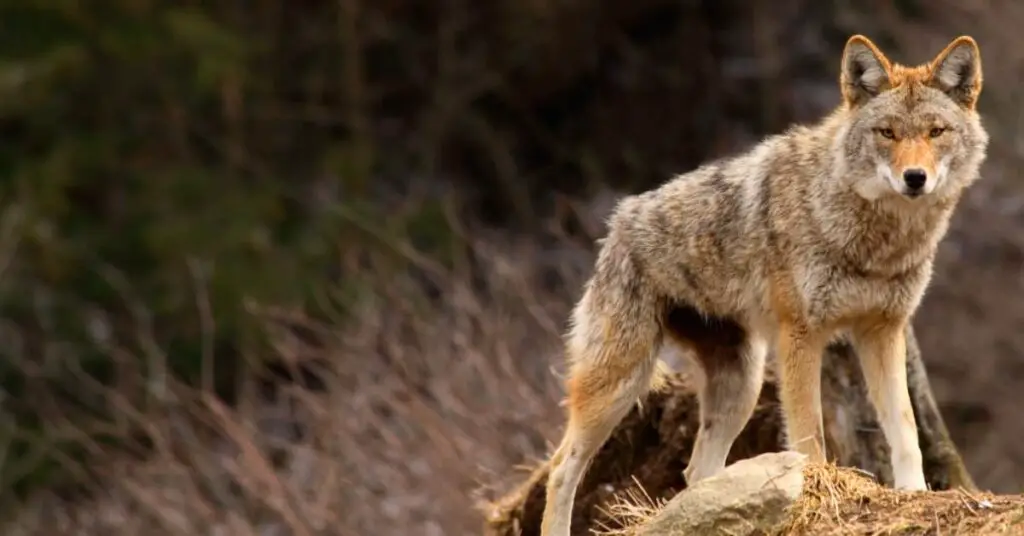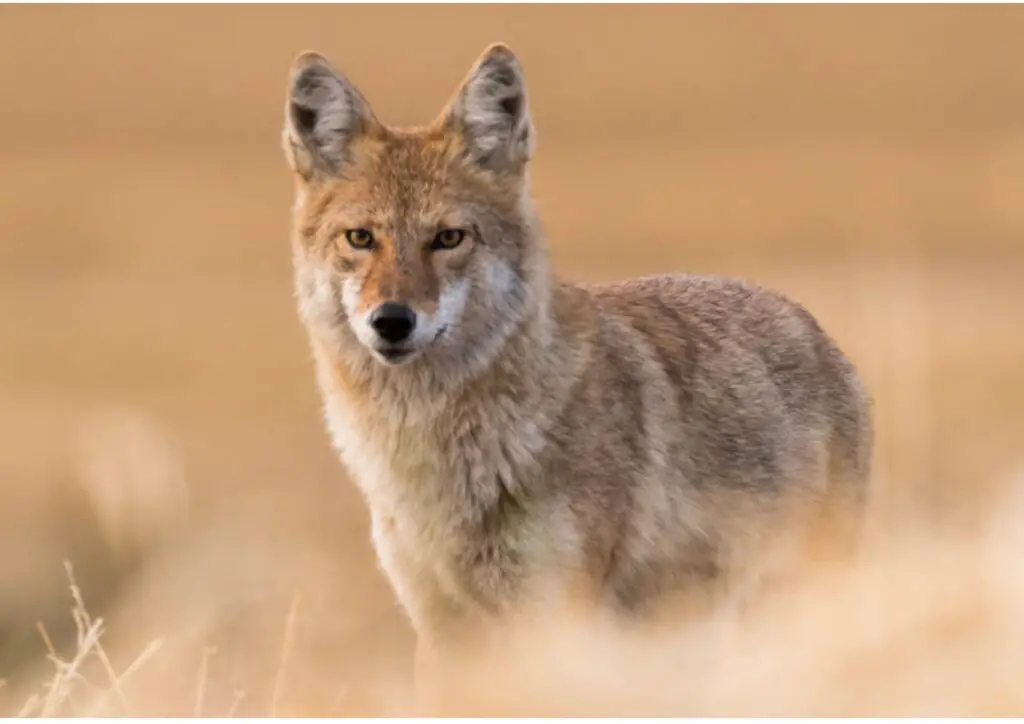Have you ever wondered if coyotes pose a threat to humans? Recent incidents in Stanley Park, Vancouver, have raised concerns about the possibility of coyote attacks on people.
In the months between December 2020 and March 2023, over 40 attacks have been reported in Stanley Park, including incidents where individuals were bitten on the leg while walking or running on a trail.
In this article, we’ll delve into the topic of coyote encounters and whether these wild animals could be a genuine danger to you and your loved ones.
As coyotes continue to adapt to urban environments, their presence has become increasingly noticeable. While these animals are generally known to avoid humans, cases like the ones in Stanley Park have shown that encounters with people are not unheard of.
To better understand the risks involved and how to mitigate them, we have analyzed the available data on documented coyote attacks on humans, focusing primarily on recent cases.
As you read on, you’ll learn about the frequency of coyote attacks, the circumstances under which they occur, and some useful tips to keep yourself safe while coexisting with these intriguing creatures.
We aim to provide you with a comprehensive and educational resource to paint a well-rounded picture of the relationship between coyotes and humans.
Recent Coyote Attacks in Stanley Park Vancouver
The aggressive encounters in Stanley Park have been a cause for concern among local residents and officials. More than 35 attacks were documented between December 2020 and August 2021, with three attacks occurring within just one week. Most of these incidents took place between dusk and dawn, posing a potential risk to visitors during those hours.
In response to this surge of attacks, conservation officers have implemented several measures to address the issue. Some of those efforts included closing Stanley Park overnight in late summer 2021 to cull the coyotes involved in aggressive attacks, a move that officials say has improved the situation (CBC).
Experts have been working to understand the reason for the abnormal behavior of these coyotes. It is speculated that their aggressiveness might be linked to people feeding the animals or the coyotes associating humans with food (CTV News).

Coyote Behavior and Aggression
Let’s explore some factors contributing to coyote aggression and the role of human behavior in such incidents.
Factors Contributing to Aggression
Several factors can contribute to heightened aggression in coyotes. Some key factors include:
- Competition for resources: As humans expand into coyote habitats, the availability of natural prey may decrease, leading coyotes to seek alternative food sources, including human-related sources.
- Protecting territory or offspring: Like many wild animals, coyotes may become aggressive if they perceive a threat to their territory or young.
- Rabies: Coyotes infected with rabies can display erratic and aggressive behavior, posing a threat to humans.
These factors can increase the likelihood of a coyote encountering humans and potentially attacking.
On a personal note, while living in the Canadian Rockies, we would commonly see coyotes along the roads and trails, and we never really felt threatened. In fact, we were often enthralled with the songs of coyotes in the evenings as we snuggled up inside our cozy cabin in the woods. We would tell our young son that the coyotes were having a party, so there was a strong element of fun involved as we listened to the coyotes yipping.
Urban Coyotes and Habituation

As coyotes adapt to living in urban environments, they may lose their natural fear of humans, a process known as habituation. Between 1977 and 2015, 367 coyote attacks on humans were reported in the U.S. and Canada, including some cases where coyotes appeared habituated to human presence.
Several strategies can help manage conflict between coyotes and humans in urban areas:
- Educate the public on coyote behavior and how to coexist safely with these animals.
- Improve waste management practices to minimize coyotes’ access to human-related food sources.
- Implement coyote conflict management techniques to alter coyotes’ behavior, such as hazing and deterrents.
Understanding the factors that contribute to coyote aggression and taking steps to manage human-coyote interactions can help reduce the likelihood of attacks and promote peaceful coexistence between humans and these adaptable animals.
Coyote Attack Statistics
Although coyote attacks on humans are relatively rare, it is essential to be aware of the statistics and recent incidents to remain informed and cautious.
According to Urban Coyote Research, (Gehrt and White, 2009) an analysis of coyote attacks on humans in the United States and Canada shows that there have been 142 reported incidents resulting in 159 victims between 1960 and 2006. Most attacks were classified as predatory (37%) or investigative (22%) in nature. It is important to note that the number of reported attacks is nearly equal between adults and children.
A more recent study from Utah State University (Baker and Timm, 2017) documented 367 attacks on humans by coyotes from 1977 through 2015, with 165 of these attacks occurring in California. Out of the 348 total victims of coyote attacks, 209 (60%) were adults, and 139 (40%) were children (age ≤10 years).
Here’s a breakdown of coyote attack statistics to keep in mind:
- Annual dog bites in the US: 4.6 million
- Fatal attacks by dogs on humans: 25 per year
- Coyote bites: 8 per year
- Fatal attacks by coyotes on humans: 0.06 per year (source)
When comparing these numbers, it becomes evident that coyote attacks are far less frequent than dog attacks.
However, the recent incidents in Vancouver serve as a reminder to always be vigilant and take necessary precautions when you’re in areas known for coyote activity.
Preventing Coyote Attacks
In this section, we’ll provide safety tips for humans, and discuss how managing coyote populations can help reduce the risk of attacks.
Safety Tips for Humans
When it comes to dealing with coyotes, your safety is of utmost importance.
If you are ever faced with an aggressive coyote, it is important to stand your ground and make loud noises to try to scare the coyote away. Do not turn your back and run, as this may trigger the coyote’s predatory instincts and cause it to chase you.
If the coyote continues to approach, throw rocks or other objects in its direction to deter it.
Here are some steps you can take to minimize potential encounters and avoid conflicts with these animals:
- Maintain a safe distance if you spot a coyote.
- Avoid feeding coyotes or leaving food sources (such as pet food, garbage, or compost) accessible.
- Install proper fencing around your property to deter coyotes from entering.
- Supervise pets and small children while outdoors, especially during dusk and dawn when coyotes are most active.
- Carry a whistle or some other noise-making device to scare off coyotes if necessary.
- Report aggressive or fearless coyotes to local authorities immediately, as aggressive coyote behavior can be a sign of a larger problem in the area.
Managing Coyote Populations
Responsible management of coyote populations is essential to reducing the risk of attacks on humans. This includes:
- Implementing non-lethal methods to control the population, such as sterilization or relocation.
- Utilizing public education and awareness campaigns to inform people about coyotes and their behavior.
- Partnering with groups like the Humane Society or local wildlife organizations for guidance on coyote management strategies.
By taking these precautionary measures and actively managing coyote populations, you can protect yourself and your community from potential coyote attacks.
Coyotes and Public Perception
When you hear about coyotes, it’s natural to be concerned about their potential threat to humans. While incidents do occur, coyote attacks on people are relatively rare. Even with the attacks in Stanley Park, Vancouver, such occurrences are generally uncommon when considering the numerous opportunities coyotes have to interact with humans and their pets throughout North America.
Still, it’s essential to recognize that as urban environments continue to expand, coyotes and humans are coming into contact more often. This inevitably leads to more human-coyote interactions that may cause concern.
When talking about human-coyote encounters, it’s important to distinguish between aggressive behavior and self-defence. Due to hunting or other threats, coyotes may perceive humans as dangerous and react accordingly. Moreover, if a coyote feels cornered or threatened, it may also become defensive.
On the other hand, there have been cases where coyotes become accustomed to humans and lose their natural fear. An overfamiliarity with humans can sometimes lead to incidents, as coyotes may no longer see people as a source of danger.
To discourage coyotes from becoming comfortable around humans, hazing techniques can be employed, such as raising your voice or clapping your hands to create discomfort for the animal and maintain a safe distance.
Public perception of coyotes can be heavily influenced by the media and the occasional sensationalized story, leading to an overestimation of the actual risk.
The reality is that coyote attacks on humans are uncommon when compared with the sheer number of interactions between people and these wild animals. By keeping your distance and understanding their behavior, you can minimize the risk of conflict.
Increasing our awareness and knowledge about coyotes is an essential step in fostering mutual respect and coexistence. Remember, a balanced ecosystem depends on predators like coyotes, who help control other animal populations.
Without predators, the numbers of herbivores like rabbits and deer can easily exceed the carrying capacity of an area, with negative impacts on the vegetation and other animals.
As we learn to share our urban spaces with wildlife, it’s crucial to take a proactive stance and adopt responsible practices that allow both humans and coyotes to thrive.

Conclusion
When we look at the data on coyote attacks, it is clear that coyotes can pose a threat to humans.
However, understanding their behavior and taking proper precautions can significantly reduce the risk of an attack on you or your loved ones.
While coyote attacks on humans are relatively rare, they can still happen. Make sure to stay aware of your surroundings and avoid known coyote territories, especially during their breeding and pup-rearing seasons. Keep your pets on a leash, and never feed or approach wild coyotes, as this can encourage aggressive behavior.
It’s important to educate yourself and others about coyote behavior and how to respond in case of an encounter. By following guidelines such as standing tall, making loud noises, and throwing objects to scare them away, you can demonstrate dominance and discourage an attack.
Lastly, remember the importance of cooperation with local authorities and wildlife agencies to ensure the well-being of both humans and coyotes. As communities grow and encroach on wildlife habitats, finding ways to coexist is crucial for the safety and protection of all involved.
References
Baker, R. and Timm, R. 2017. Coyote attacks on humans, 1970–2015: implications for reducing the risks. Human–Wildlife Interactions 11(2):120–132, Fall 2017. https://digitalcommons.usu.edu/cgi/viewcontent.cgi?article=1387&context=hwi
Bekoff, Marc. Coyotes: Dispelling Myths About Who They Are, What They Do. https://www.psychologytoday.com/us/blog/animal-emotions/201712/coyotes-dispelling-myths-about-who-they-are-what-they-do
Gehrt, S. and White, L. 2009. Coyote Attacks on Humans in the US And Canada. Urban Coyote Research Project. Human Dimensions of Wildlife, 14:419–432, 2009 DOI: 10.1080/10871200903055326 UHDW 1087-1209 1533-158X https://urbancoyoteresearch.com/resource/coyote-attacks-humans-us-and-canada
Guardian 2021, Mystery over surge in coyote attacks in Vancouver park https://www.theguardian.com/world/2021/aug/24/mystery-over-surge-in-coyote-attacks-in-vancouver-park
Pawson, Chad, 2022. CBC.ca. Vancouver officials optimistic changes in Stanley Park are bringing aggressive coyote attacks to heel. https://www.cbc.ca/news/canada/british-columbia/stanley-park-aggressive-coyote-attacks-situation-improved-2022-1.6501269
Pester, Patrick, 2021. Coyotes. Livescience.com: Facts about the wily members of the Canidae family. https://www.livescience.com/27976-coyotes.html


